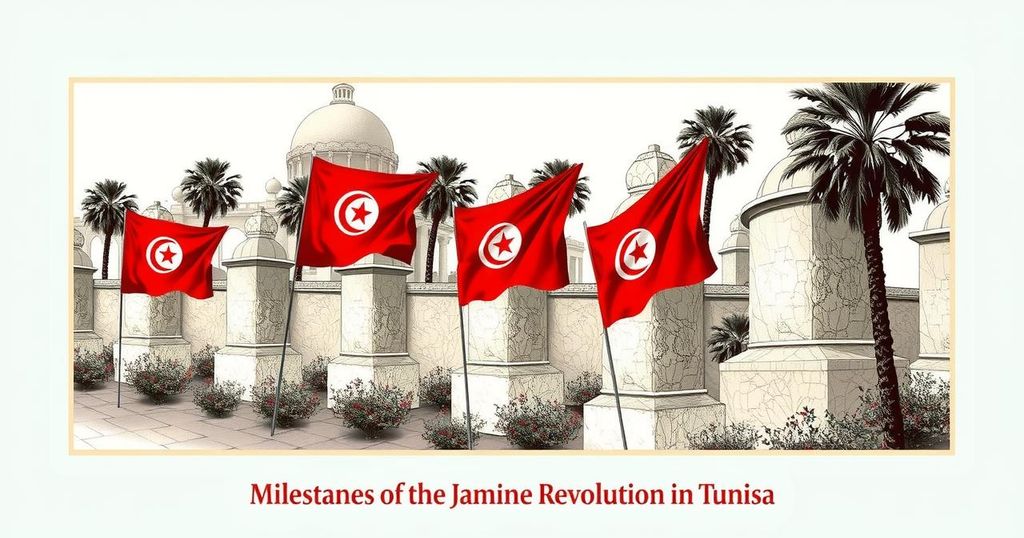The Jasmine Revolution in Tunisia (December 17, 2010 – January 14, 2011) was a popular uprising driven by widespread dissatisfaction with corruption, poverty, and political repression under President Zine al-Abidine Ben Ali. Initiated by Mohamed Bouazizi’s self-immolation, the protests led to Ben Ali’s ousting and inspired similar movements across the Middle East and North Africa in what became known as the Arab Spring.
The Jasmine Revolution represents a significant uprising in Tunisia that took place from December 17, 2010, to January 14, 2011, aimed at addressing systemic issues such as corruption, poverty, and oppression under President Zine al-Abidine Ben Ali’s regime. Triggered by the self-immolation of Mohamed Bouazizi, a fruit vendor distressed by abusive practices from officials, this revolt ignited nationwide protests, leading to intense civil unrest and ultimately forcing Ben Ali to resign. The effectiveness of this movement set a precedent, inspiring subsequent uprisings across the Middle East and North Africa, commonly recognized as the Arab Spring.
Beginning with Bouazizi’s act of desperation, demonstrations erupted throughout Tunisia, fueled by widespread dissatisfaction regarding economic hardships and governmental repression. The Tunisian authorities initially responded with violence, leading to numerous fatalities among protesters. Political pressure mounted internationally as the chaos escalated, leading to Ben Ali’s dismissal of his interior minister and renewed commitments to reform, although these actions fell short of placating the sustained public outcry. On January 14, 2011, as clashes intensified, Ben Ali departed Tunisia, marking the end of his lengthy rule and ushering in the interim government led by Prime Minister Mohamed Ghannouchi.
In the tumultuous aftermath of Ben Ali’s flight, Tunisia faced institutional instability, and calls for thorough reforms grew louder. Demonstrations persisted partly due to the involvement of former regime members in the interim leadership. In response, the new administration sought to ensure political inclusivity and aimed to stabilize the economy by lifting censorship and allowing for the establishment of opposition parties. This tumultuous transition culminated in significant political changes, with the drafting of a new constitution that involved delicate negotiations between secular and Islamic factions.
The democratic transition proved challenging as tensions persisted among various political groups, requiring the eventual promulgation of a constitution in January 2014. This new framework was celebrated as a fair balance, facilitating Tunisia’s first peaceful transfer of power following democratic elections. The Jasmine Revolution not only serves as a cornerstone in Tunisian history but also sparked a series of similar pressures for reform in neighboring nations, further altering the political landscape of North Africa and beyond.
The Jasmine Revolution emerged within the wider context of the Arab Spring, a series of anti-government protests and uprisings across the Arab world. The motivations for the uprising were deeply rooted in widespread discontent over corruption, social injustice, and economic struggles. The movement was notably catalyzed by Mohamed Bouazizi’s act of self-immolation, which resonated with many Tunisians facing repression and unemployment. This event became a powerful symbol of the struggle against government oppression and served as a rallying point for widespread demonstrations against Ben Ali’s government which had been in power for over two decades.
In summation, the Jasmine Revolution was a pivotal moment in Tunisian and Arab history, illustrating the power of popular protest in challenging systemic injustices and authoritarian rule. The movement not only dismantled a longstanding regime but also laid the groundwork for Tunisia’s gradual transition to democracy. Moreover, it ignited a broader regional awakening, leading to protests across multiple countries that sought similar reforms and democratic governance, thus highlighting the interconnected nature of political movements within the Arab world.
Original Source: www.britannica.com






